20 Birds With Orange Chests (With Pictures)
Last Updated on
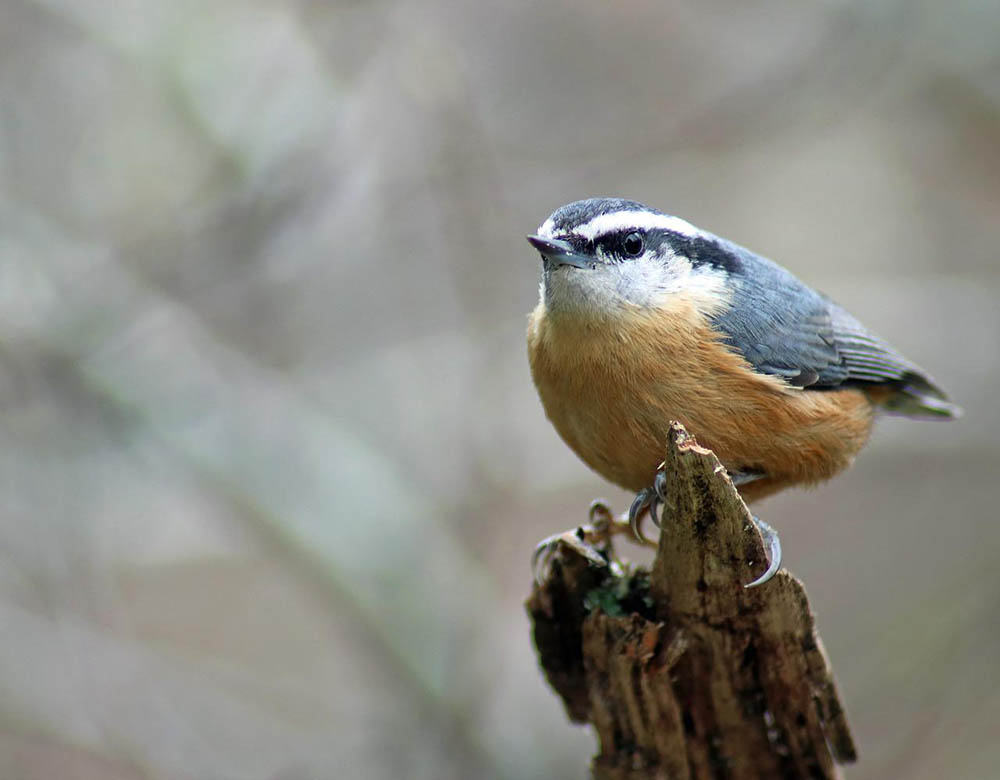
Birdwatching is a pleasant and rewarding hobby that can offer a lifetime of fun. With so many birds native to North America, it is one of the best places to get a view of birds from all different families. Among the most popular birds to observe and attract are the beautiful and brightly colored species, which are often exotic. However, North America is home to a wide range of colored birds, particularly those with orange coloration. Orange coloration can be found in orioles, hummingbirds, doves, penguins, parrots, and many other families of birds.
The way birds acquire their orange coloring varies between species, however, it is widely believed that this appearance is a result of their diet. Birds who eat diets rich in carotenoids, a class of red fat-soluble pigments, generally exhibit bright orange plumage. Depending on the lighting conditions, cleanliness, and geographic location of a given bird, their feathers can vary from darker burnt oranges to almost fluorescent neon oranges.
Male and female birds of the same species can even exhibit different intensities of orange coloration. We’ve put together this list of birds with this signature coloring so you can learn more about your local, orange-feathered friends.

The 20 Birds With Orange Chests
1. Baltimore Oriole (Icterus galbula)

| Length: | 6.7-7.5 in. |
| Weight: | 1.1-1.4 oz. |
| Wingspan: | 9.1-11.8 in. |
The Baltimore Oriole is a medium-sized blackbird that is commonly found in Eastern North America. This migratory songbird is characterized by long legs, a pointed beak, a thick neck, and its signature, bright-orange undercarriage. Male Baltimore Orioles have a black head and wings, which are adorned with broad, white wing bars.
Their breasts, outer tail feathers, and shoulders, however, are typically a brilliant shade of golden-orange. On the other hand, the plumage of the female Baltimore Oriole is typically much more muted with tones of gray-brown on the wings and a pale yellow everywhere else. Like the males, the females of this species also sport signature white wing bars.
Baltimore Orioles are common backyard birds in the Northeastern United States and are usually found perched high in the treetops. These birds are omnivorous and fond of sweet fruit, nectar, and insects, so planting bright fruits such as raspberries and crab apples can attract these fiery friends to your yard. Unlike many other birds, however, Baltimore Orioles are unique because of their preference for the ripest, darkest fruit. Even if other fruit such as green grapes or yellow cherries are present and ripe, Baltimore Orioles will generally ignore them in favor of the darkest berries.
2. Western Bluebird (Sialia mexicana)

| Length: | 5.9-7.1 in. |
| Weight: | 0.8-1.1 oz. |
| Wingspan: | 11.4-13.4 in. |
The Western Bluebird is a small, stocky, and colorful thrush that calls the open woodlands of the American West its home. The adult males of this species are characterized by bright blue heads and backs along with a bright and contrasting copper underside. The females, however, are much paler in comparison with grayish-brown plumage and light orange chests.
Western Bluebirds are primarily insectivorous, sweeping through the air with unparalleled accuracy to catch dozens of flies and other insects. However, when they are available, berries are also a choice meal of the Western Bluebird. These beautiful birds can commonly be seen perched atop fence posts or on low perches on the edges of woodlands. To invite Western Bluebirds to your backyard, fill a bird feeder with mealworms, one of this bird’s favorite snacks. Installing nest boxes on your property can also attract Western Bluebirds as they normally nest in tree holes during breeding season.
3. Scarlet Tanager (Piranga olivacea)

| Length: | 6.3-6.7 in. |
| Weight: | 0.8-3.1 oz. |
| Wingspan: | 9.8-11.4 in. |
Scarlet Tanagers are some of the easiest birds to identify in the mature deciduous forests of Eastern North America due to their blindingly bright coloration. Male Scarlet Tanagers aren’t easy to miss and are characterized by a saturated, flame-colored body and head. This beautiful, signature coloration is further accentuated with dark black wings and tail feathers, which can take up to two years to fully come in.
The females, however, are almost entirely yellow-green in color, with tinges of light brown and gray apparent on their wings and backs. During the migration season, however, male Scarlet Tanagers molt their signature fiery feathers in favor of the yellow-green ones sported by their female counterparts.
Although Scarlet Tanagers stand out from an Avian crowd, they can be frustratingly difficult to find as they prefer to perch high in forest canopies and are often obscured by foliage. Scarlet Tanagers prefer to glean the fruit from a variety of berry plants, including blackberries, mulberries, strawberries, and huckleberries, although they eat insects as well. To attract these uniquely colorful birds to your yard, it is advised to plant a variety of dark and juicy fruiting plants near your home.
4. Bullock’s Oriole (Icterus bullockii)

| Length: | 6.7-7.5 in. |
| Weight: | 1.0-1.5 oz. |
| Wingspan: | 12.2 in. |
Bullock’s Orioles are found in the Western United States where they glean the open woodlands in search of insects, fruit, and nectar. Male Bullock’s Orioles are fiery orange in color, with a crisp black line emanating from their eyes. Additionally, males have black throats and wings adorned by a bright white patch.
The females, however, are washed in paler shades of gray and orange. Bullock’s Orioles are unique because of their interesting nest building behavior. Oftentimes, you can see these brilliant songbirds hanging upside-down from tree branches while weaving intricate, hanging nests.
Bullock’s Orioles typically like to hang out in streamside woodlands where they forage in the tree branches. Oftentimes, they are attracted to homes with hummingbird feeders, which they raid for their sweet sugar water reminiscent of flower nectar. Alternatively, you can also hang orange slices from the trees or fill a bird feeder with mealworms to attract this unique feathered friend.
5. American Robin (Turdus migratorius)
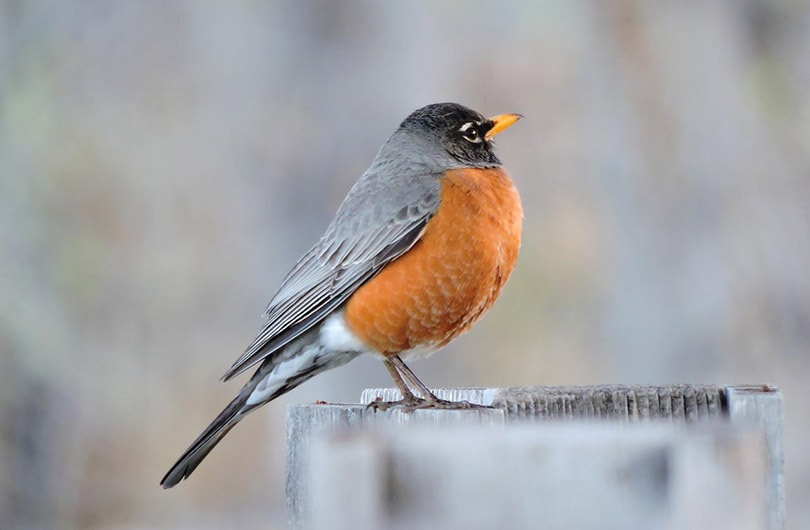
| Length: | 7.9-11.0 in. |
| Weight: | 2.7-3.0 oz. |
| Wingspan: | 12.2-15.8 in. |
American Robins are common lawn ornaments across North America and are commonly seen pulling juicy earthworms from the grounds of open woodlands in early spring. Adult American Robins, are not sexually dimorphic, meaning males and females look the same. These birds are characterized by bright yellow beaks with ash-brown wings, back, and heads. Their most defining feature, however, is their bright and round copper-toned belly.
Robin eggs are unique because of their bright blue coloration due to a pigment called biliverdin. According to some studies, females that lay brighter blue eggs are seen as healthier by their mates, encouraging them to take more interest in their young.
In the spring and summer, American Robins like to feast on insects above and underground. However, in the fall and winter, they can commonly be found eating fruit. In fact, some Robins can even become intoxicated from eating an exclusive diet of honeysuckle berries, which are common in some areas. American Robins are at home in wild forests and cities, so you don’t have to do too much to attract them to your yard. However, installing nesting boxes and a bird feeder is almost guaranteed to attract these harbingers of Spring to your home.
6. Say’s Phoebe (Sayornis saya)

| Length: | 6.7 in. |
| Weight: | 0.7-0.8 oz. |
| Wingspan: | 13 in. |
Say’s Phoebe is a small, long-tailed fly catching bird characterized by an unusually large head. These birds can be found in Western North America, where they are commonly seen perched low to the ground on shrubs or fence posts on the outskirts of deserts, sagebrush, badlands, or barren foothills. Both male and female Say’s Phoebes have the same coloration, with gray-brown feathers on top and a cinnamon-orange chest.
This small Phoebe is known for nesting everywhere and isn’t limited to using the nests of other species as well. Additionally, Say’s Phoebes tend to use the same nest year after year, so if a breeding pair makes their home in your backyard, you can expect them to return consistently.
Say’s Phoebes are mainly insectivores and are surprisingly not attracted to bird feeders. Instead, they prefer to snap bees, wasps, winged ants, dragonflies, moths, and other critters out of the air. Occasionally, Say’s Phoebes will also eat berries. To attract these birds to your home, plant some native shrubs to provide them with foraging opportunities and encourage nest-building.
7. Rufous Hummingbird (Selasphorus rufus)
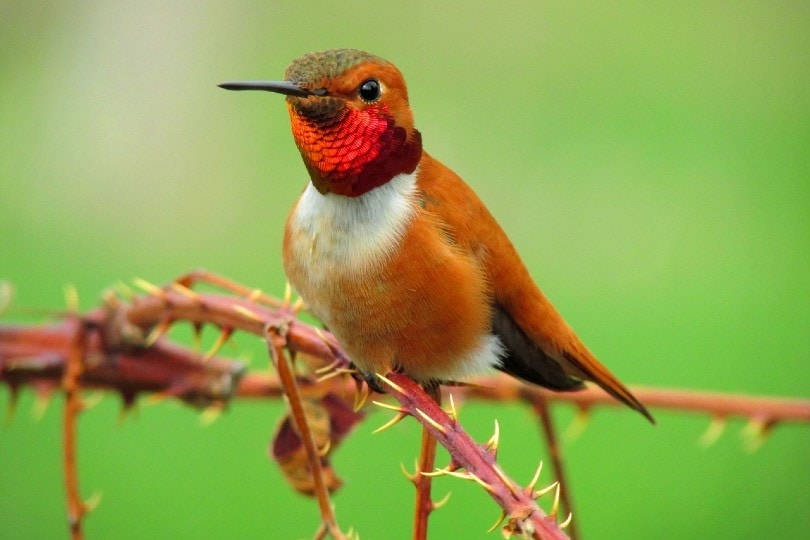
| Length: | 2.8-3.5 in. |
| Weight: | 0.1-0.2 oz. |
| Wingspan: | 4.3 in. |
Rufous Hummingbirds are among the feistiest hummingbirds found in North America, dominating the western reaches of North America. In the spring, they can be found in California, but in the summer breeding season, they migrate to the Pacific Northwest and Alaska. However, during the fall and winter, Rufous Hummingbirds can be seen completing their migratory circuit through the Rocky Mountains.
Male specimens are a fiery orange color throughout, while females adopt tinges of green hues in addition to their vibrant and fiery plumage. Rufous Hummingbirds are unique because they breed further north than any other species of hummingbird. Additionally, they relentlessly attack other hummingbirds, even those twice their size, to claim the rights to their preferred flowers and feeders.
You might see Rufous Hummingbirds in your yard for just a few weeks at a time if you’re lucky enough to live in an area they call home. These miniature birds are always on the move looking for their next source of nectar, so they’re never in town for too long. To attract these flame-colored birds to your home, fill hummingbird feeders with their signature cocktail of diluted sugar water and watch them flock to your yard.
8. Red Knot (Calidris canutus)

| Length: | 9.1-10.6 in. |
| Weight: | 4.4-7.2 oz. |
| Wingspan: | 22.4-23.6 in. |
The Red Knot is a species of sandpiper that calls every continent besides Antarctica its home. This shorebird is known for migrating across exceptionally long distances, nesting in the high Arctic and moving as far south as South America, Africa, and Australia in the winter months. Adult Red Knots are not sexually dimorphic, meaning the adult males and females look the same.
Red Knots are characterized by a bright terracotta belly, a mottled gray-black back, and a medium-length, pointed black bill. In fact, their bills are home to a special organ called a Herbst corpuscle, which they use to detect clams and other mollusks through differences in pressure. Red Knots then eat these mollusks by swallowing them whole, allowing their muscular gizzards to crush and process the shells.
Red Knots are most commonly found along sandy beaches and mudflats where they forage for food. However, Red Knots have become increasingly rare due to population decline. Red Knots and their subspecies are federally threatened birds, estimated to make up about 1 million individuals in total. This is because one of their main food sources, horseshoe crab eggs, have been unsustainably harvested for decades.
9. Varied Thrush (Ixoreus naevius)

| Length: | 7.5-10.2 in. |
| Weight: | 2.3-3.5 oz. |
| Wingspan: | 13.4-15.0 in. |
The Varied Thrush is a songbird that makes its home in the peaceful, idyllic forests of the Pacific Northwest. They can frequently be found foraging for insects, seeds, and berries in the wet shrubs, ferns, and mosses of temperate rainforests.
The male Varied Thrush is characterized by a dark gray back and breast band contrasted by a burnt-orange chest. Females, on the other hand, look much like the males but are paler in color. Varied Thrushes are known for aggressively protecting themselves against fellow members of their species and others, frequently defending their feeding territories against birds much larger than them.
As Varied Thrushes are somewhat shy, they can be difficult to attract to your yard. However, planting native fruiting shrubs in the warmer months and installing ground feeders in the winter can coerce these sweet songbirds into visiting you for a time.
10. Blackburnian Warbler (Setophaga fusca)

| Length: | 4.3-4.7 in. |
| Weight: | 0.3-0.4 oz. |
| Wingspan: | 7.9-9.1 in. |
Blackburnian Warblers are most commonly found in the northeastern United States and Canada, however, they also make an annual migration to northern South America. These solitary birds are typically found perched high in the canopies of mixed-deciduous forests where they are often obscured by foliage, making them tough to spot.
Male Blackburnian Warblers are characterized by their detailed black and white plumage which is offset by a flamey orange face and throat. The females, however, are much lighter in comparison, sporting tones of pale yellow and brown.
Blackburnian Warblers are unique in their breathtaking territorial conflicts, where rival males chase one another in an event that resembles an air show. Throughout this exaggerated flight, these birds trace loopy whirling patterns in the sky as they establish their territories and attempt to intimidate each other. The diet of the Blackburnian Warbler consists of insects and berries, but one of their favorite snacks are caterpillars. These birds also love water, so a bird bath or other form of running water can coerce them into your yard.
11. Altamira Oriole (Icterus gularis)
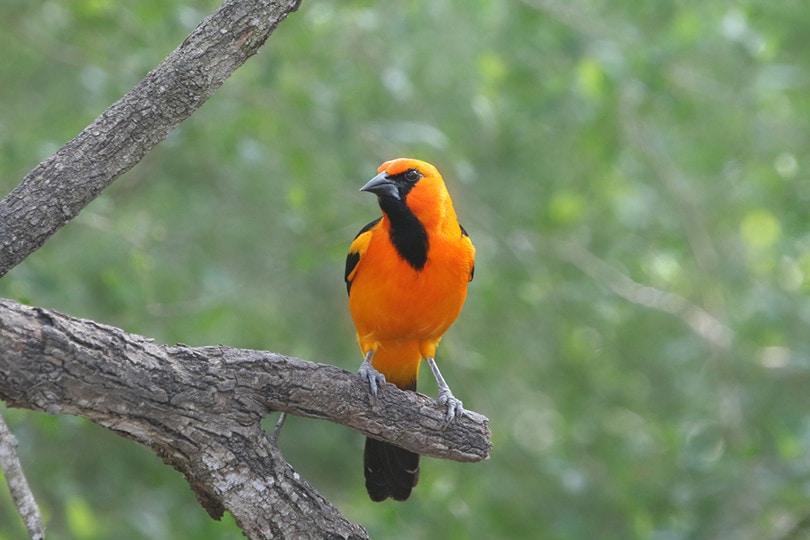
| Length: | 8.3-9.8 in. |
| Weight: | 1.7-2.3 oz. |
| Wingspan: | 14.2 in. |
The Altamira Oriole is a stunning tropical bird that makes its home along a small region of Texas’ Rio Grande Valley. These solitary birds can frequently be found perched in tall trees and are easy to spot early in the morning, when the males sing a beautiful and rich song. Male and female Altamira Orioles look similar to each other, sporting a signature, nearly neon orange body.
These Orioles additionally have black patches on the face, throat, tail feathers, and wings, which also feature bright white wing bars. Female Altamira Orioles are known for weaving intricate, hanging nests that can be up to 26 inches long. Interestingly, although these birds are solitary nesters, they haven’t been observed to be aggressive or territorial.
Altamira Orioles primarily feed on fresh fruit, flower nectar, sunflower seeds, and insects such as grasshoppers. Including these treats along with native plants and a hummingbird feeder in your yard can easily attract these bright individuals to your home and may even inspire them to build one of their signature nests.
12. Allen’s Hummingbird (Selasphorus sasin)
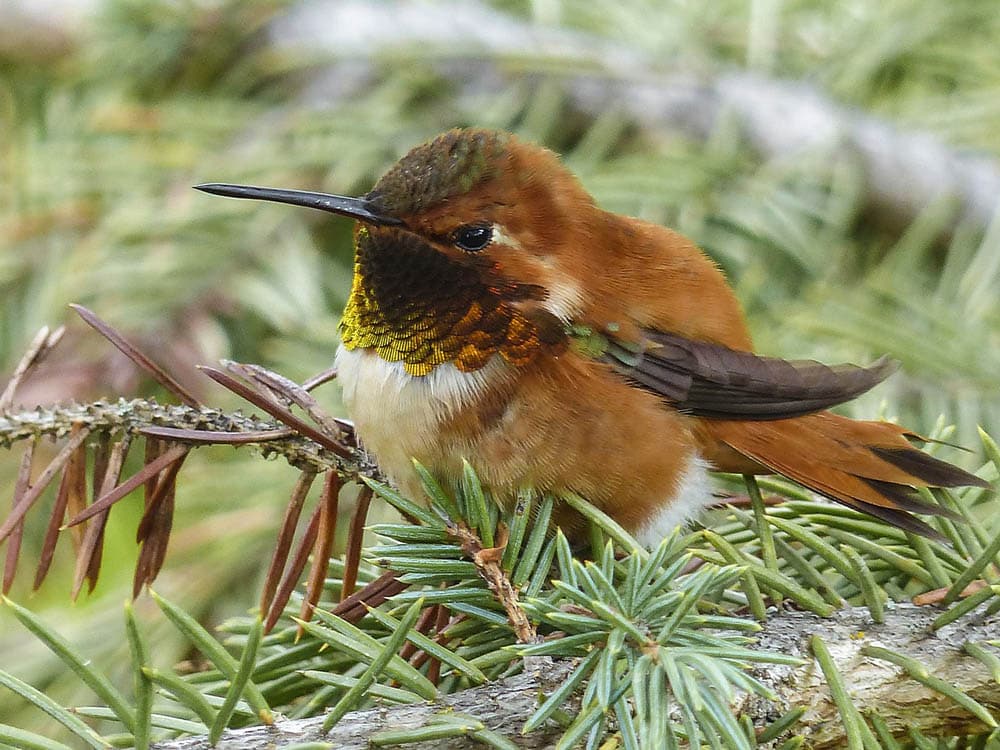
| Length: | 3.5 in. |
| Weight: | 0.1 oz. |
| Wingspan: | 4.3 in. |
Allen’s Hummingbirds can frequently be found along the southwestern coast of the United States and Mexico. Males are a fiery orange color throughout with a brilliant and reflective flame-colored throat, while females adopt tinges of green hues in addition to their vibrant and fiery plumage. These hummingbirds like to set up shop in coastal scrub and chaparral, where they can easily be identified by the sharp squeals of their signature display flight.
During breeding season, males will flash their colors and put on an aerial show reminiscent of a Broadway production for the females. As this heart-pounding aerobatics show goes on, the males fly in arcs before climbing into the sky and making a sharp dive towards the ground. This dive causes their sharp tail feathers to emit a sharp squeal as a result of the aerodynamic forces acting on them.
Allen’s Hummingbirds are unique because the males and females live in different habitats during their breeding season. At the start of the season, the males set out in search of a coastal territory, where it perches on exposed branches waiting for a female to arrive. The females, however, visit the males to mate before returning to dense coastal forests where they build a nest and raise their young. Allen’s Hummingbirds follow a diet typical of their family and feed on the sweet nectar of colorful flowers. Thus, adding a hummingbird feeder filled with sugar water to your yard can help attract them. Another great way to attract these moderately elusive birds is by planting a “hummingbird garden” full of bright, native flowers.
13. Aplomado Falcon (Falco femoralis)

| Length: | 15.0-16.9 in. |
| Weight: | 7.3-17.6 oz. |
| Wingspan: | 35.0 in. |
Aplomado Falcons are an endangered species of bird that calls the dry grasslands and deserts of the southwestern United States its home. These gorgeous raptors are characterized by black and white facial stripes and a tricolored undercarriage tinted with shades of burnt orange, brown, and white.
Typically, Aplomado Falcons can be found perched in pairs or hunting small mammals and reptiles on foot. However, these raptors are also known for catching other birds and insects in midair, performing impressive aerial dives to acquire their meals. Unlike other raptors, Aplomado Falcons interestingly don’t build their own nests. Instead, they repurpose the nests of other predatory birds, often evicting existing birds from their nests.
Because Aplomado Falcons are endangered, finding one can prove to be a difficult task. However, this impressive raptor is slowly being reintroduced in South Texas. If you’re lucky enough to share this home with the Aplomado Falcon, you may have the chance to witness this magnificent bird of prey in action.
14. Orchard Oriole (Icterus spurius)
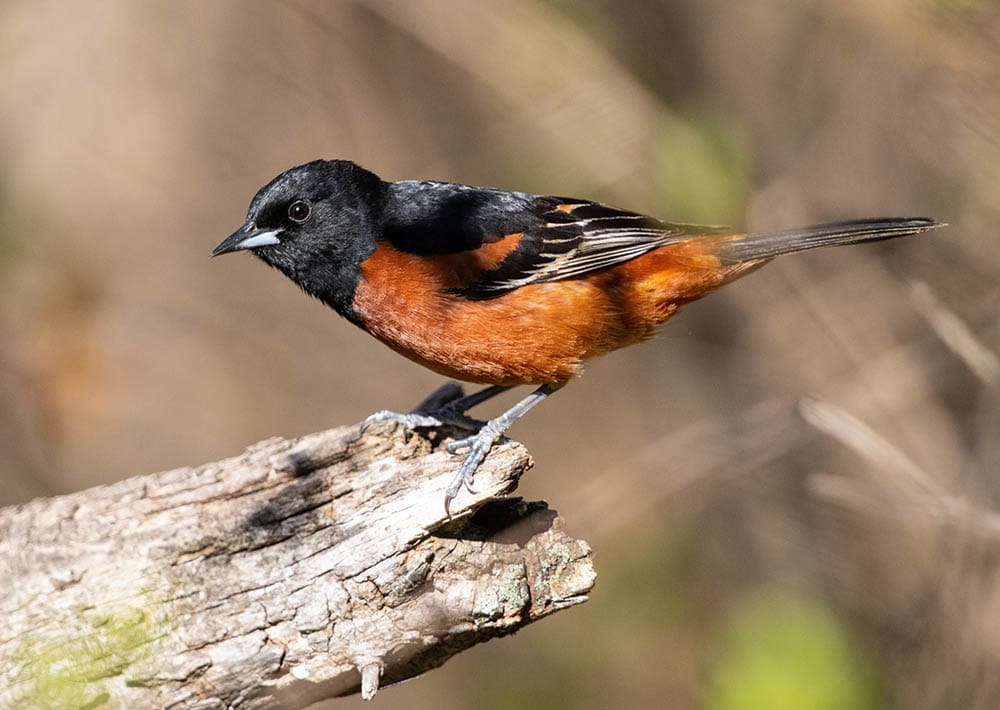
| Length: | 5.9-7.1 in. |
| Weight: | 0.6-1.0 oz. |
| Wingspan: | 9.8 in. |
Unlike other Orioles, male Orchard Orioles sport a deep, rusty orange chest similar to the American Robin, with mostly black and chestnut upper feathers. The females, on the other hand, are pale greenish-yellow in color with gray and white tones on their tail feathers and wings.
Orchard Orioles are most at home in the open woodlands across the eastern United States and Canada, often nesting near parks, river edges and orchards, from which they get their name. Orchard Orioles are also relatively calm and social, tending to nest in groups and often establishing multiple nests in the same tree.
Orchard Orioles prefer to forage for insects such as spiders in the tops of trees, however, they have also been observed drinking nectar from flowers and eating other berries and fruits. Orchard Orioles are relatively easy to attract and can be lured by shrubby foliage that gives them an opportunity to forage for all manners of insects. Additionally, during their migration in the fall, Orchard Orioles may be drawn to dark fruits such as mulberries and chokecherries. Another great way to attract these shy songbirds is through hummingbird feeders, which they occasionally visit for a sweet and refreshing snack.
15. Red-Breasted Nuthatch (Sitta canadensis)
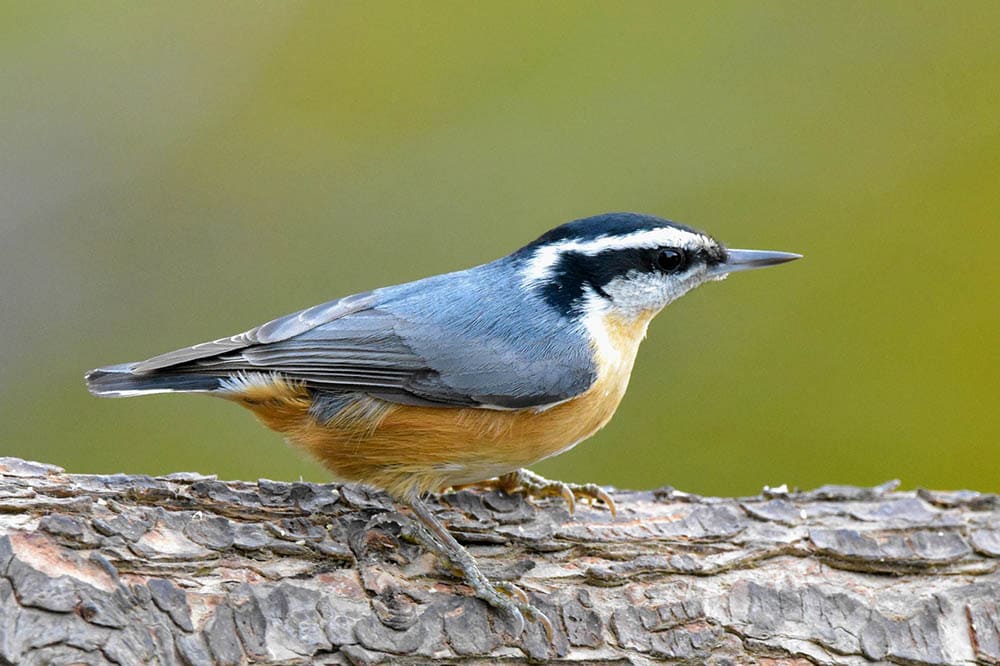
| Length: | 4.3 in. |
| Weight: | 0.3-0.5 oz. |
| Wingspan: | 7.1-7.9 in. |
The Red-Breasted Nuthatch is a unique and interesting bark forager that calls the entirety of the United States and southern Canada its home. This bird can primarily be found in the coniferous forests of these areas, often building nests in fir, hemlock, pine, red cedar, oak, maple, hickory, and birch trees. These small and active birds are a bluish-gray in color with a bold black and white striped face. Additionally, their underside is a bright orange-cinnamon in color, which is slightly paler in females.
Red-Breasted Nuthatches forage in a similar manner to Woodpeckers, creeping up, down, and sideways along tree trunks and branches. Using their beaks, they peer into tiny crevices and pry under flakes of bark to find tasty insects. Uniquely, the Red-Breasted Nuthatch also collects the resin from coniferous trees, which it uses to remodel its nest.
The male primarily lays resin on the outside of the nesting hole while the female spreads it around inside, often using a piece of bark as an applicator. It is thought that this behavior helps with keeping predators and competitors out of the nest. However, the Red-Breasted Nuthatch is not an easy target, as its aggressive nature makes it willing to fight any bird that gets too close. Red-Breasted Nuthatches are attracted to bird feeders, so putting one up may entice a breeding pair to set up shop and raise their young in your yard.
16. Vermilion Flycatcher (Pyrocephalus rubinus)
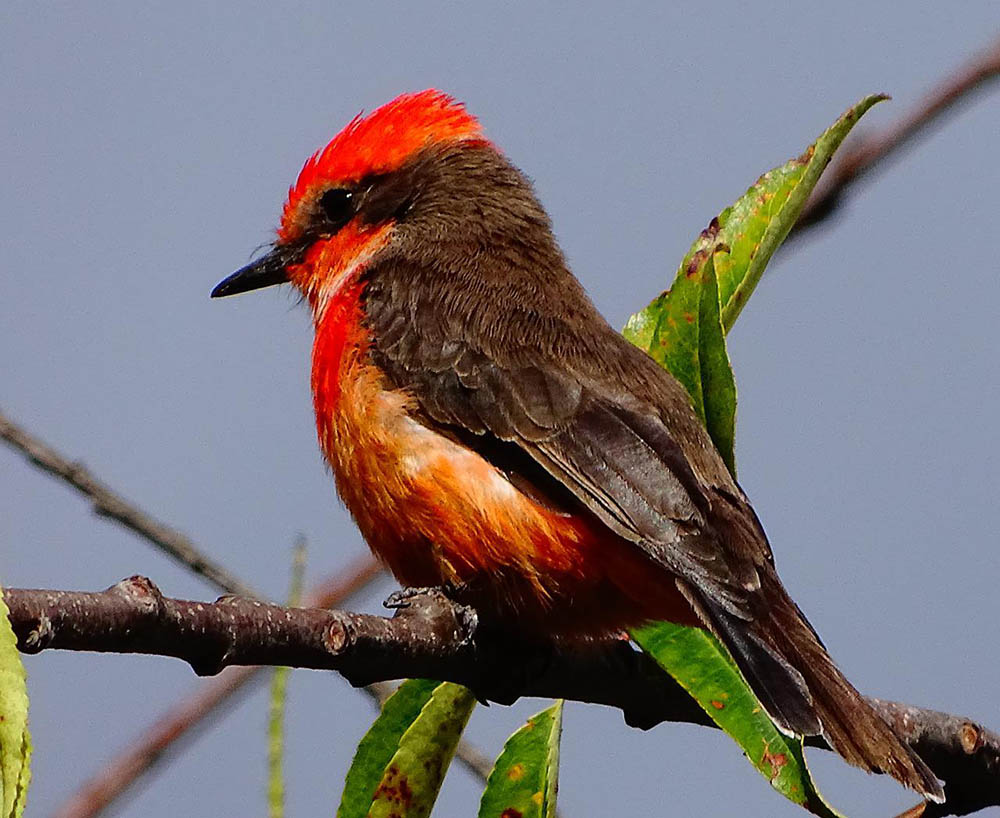
| Length: | 4.3-5.1 in. |
| Weight: | 0.2-0.3 oz. |
| Wingspan: | 6.3-7.5 in. |
Vermilion Flycatchers are a colorful bird found throughout Mexico and the southern United States inhabiting deserts, riverine woodlands, and tropical lowlands. Adult males are characterized by a brilliant orange chest and head with a gray-brown mask through their eyes that extends down the wings and tail. Females, however, are fainter in color with mostly chestnut feathers and an orange blush on their underparts. This bird, reminiscent of a fiery inferno, is often found perched within 10 feet from the ground in the insect rich edges of stream corridors.
Vermilion Flycatchers are unique in their mating habits, with the male’s displaying a fluttering air show to lure potential mates. Male specimens will also bring females gifts in the form of butterflies and other flashy insects in an attempt to court them. Although these birds inhabit some small areas of the southern United States, they are more commonly found in Central and South America, making them difficult to come across.
17. Spot-Breasted Oriole (Icterus pectoralis)
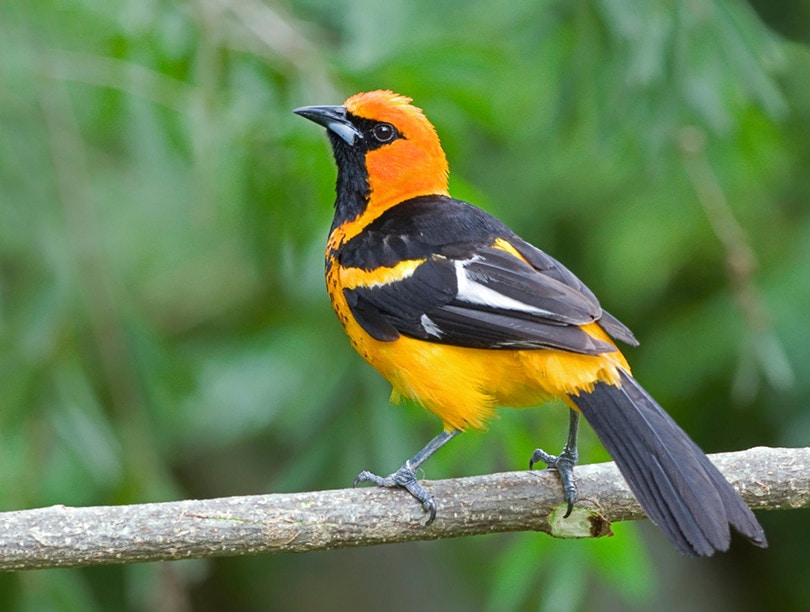
| Length: | 8.3-9.4 in. |
| Weight: | 1.8 oz. |
| Wingspan: | 13 in. |
The Spot-Breasted Oriole is native to Southern Mexico and Central America, although there is a sizable population of them in South Florida, where they are a common suburban nester. Adult Spot-Breasted Orioles are medium-sized songbirds characterized by a saturated orange head and body. Their faces, backs, and tails, however, sport a contrasting black color, emphasizing their already brilliant coloring.
The defining characteristic of this bird is the unique spotted pattern on their breasts, from which they get their name. Unlike most other birds in the Oriole family, Spot-Breasted Orioles are not sexually dimorphic, meaning both males and females inherit the same colorful pattern.
Spot-Breasted Orioles consume a diet of berries, flower nectar, and insects. As such, they are commonly found in areas where fruit is cultivated. In the spring, the males sing a beautiful and rich song to defend their territory while the female builds a long, woven nest of grass and other plant fibers well above the ground. However, as this species is uncommon throughout the United States, not much else is known about their nesting behavior.
18. Barn Swallow (Hirundo rustica)

| Length: | 5.9-7.5 in. |
| Weight: | 0.6-0.7 oz. |
| Wingspan: | 11.4-12.6 in. |
Barn Swallows are the most abundant and widely distributed species of swallows, being found all over North and Central America. This common avian resident is characterized by a gleaming, cobalt blue and black back with a rusty orange underside and face. Barn Swallows can usually be found feeding on insects in meadows, fields, and farmyards close to water and mud, which they use to build their signature nests.
True to their names, Barn Swallows typically build these nests under the eaves of barns, under bridges, and in the crevices of manmade structures. Uniquely, unmated Barn Swallows may even kill the young of a nesting pair in order to mate with the female. When raising their chicks, these intelligent birds have also been observed getting help from other birds. In most cases, these “helpers” are older siblings from previous seasons.
This bird exhibits an interesting feeding behavior, where it forages for flying insect prey in midair through a coordinated aerial dance of swoops and dives. Although it doesn’t take much to attract a Barn Swallow to your yard, providing a nesting structure and a source of mud can help speed the process along. Additionally, Barn Swallows like feeding on ground egg and oyster shells placed in a shallow bird feeder, which can attract more of these vibrant swallows to your home.
19. Black-Headed Grosbeak (Phenucticus melanocephalus)

| Length: | 7.1-7.5 in. |
| Weight: | 1.2-1.7 oz. |
| Wingspan: | 12.6 in. |
Black Headed Grosbeaks are a common bird found in the suburbs, brushy deserts, and mountain forests of western North and Central America. The males are characterized by a thick beak, black head, and black and white striped wings. Additionally, Black-Headed Grosbeaks sport a signature orange coloration on their chests and necks, which is less flamboyant in the females of the species.
Most sexually dimorphic birds do not take on an equal share of the young rearing, however both male and female Black-Headed Grosbeaks contribute to incubating and feeding their young. Sometimes, the female Grosbeak may even sing the male’s signature song to trick him into thinking his nest is being intruded. This unique behavior encourages the male to spend more time in the nest with his young.
These birds are one of the few predators of Monarch butterflies because they are immune to the toxic poison in them. Based on observations, Black-Headed Grosbeaks feed on Monarch Butterflies in roughly 8-day cycles, supposedly to give their bodies enough time to eliminate their inherent toxins. In addition to insects, these also birds love sunflower seeds, which they use their massive beaks to break open with ease. Therefore, adding a birdfeeder full of sunflower seeds is one of the surefire ways to attract these flame-bellied individuals to your yard.
20. Hooded Oriole (Icterus cucullatus)
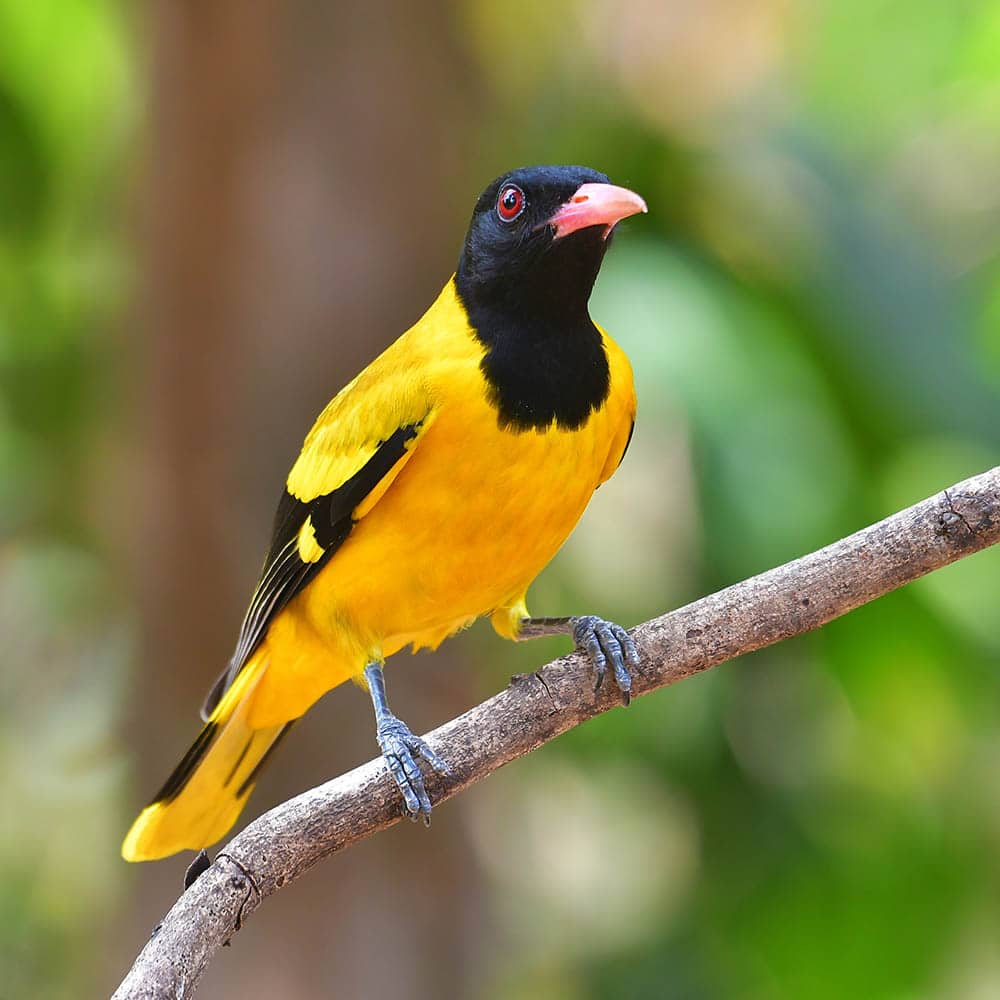
| Length: | 7.1-7.9 in. |
| Weight: | 0.8 oz. |
| Wingspan: | 9.1-11.0 in. |
Hooded Orioles, also known as “Palm Leaf Orioles,” are a brightly colored species in the blackbird family found in the southwestern United States and Central America, where they live in open woodlands with scattered trees. This species of Oriole is relatively large and sports a characteristic curved and pointed beak.
The males can vary from shades of golden yellow to a brilliant fiery orange on their rumps, hoods, and bellies. Furthermore, Hooded Orioles have a dark black mask, tail feathers, and wings that are accentuated by broad white wing bars. The females, on the other hand, are more olive-yellow in color and contrasted by dull, gray-brown plumage.
Hooded Orioles primarily forage insects from the palm trees they tend to frequent. However, they also use their long, curved beaks to open flowers, drill holes in tree bark, and dig into ripe and juicy fruits. Interestingly, female Hooded Orioles tend to suspend their nests from palm leaves, which they use as a platform to secure them.
By stringing a variety of plant fibers through holes in the leaves, the female Oriole is able to effectively “sew” her intricate and woven nest to the leaf. Hooded Orioles can be attracted to your neighborhood by tying sliced oranges to a tree or other platform. Alternatively, you can also install a hummingbird feeder, which Hooded Orioles are frequently found to take advantage of in lieu of migrating south for the winter.

Conclusion
Overall, almost every family of birds includes at least one species with the flashy, flame-like coloring many bird watchers often look for. This orange coloring can vary in hue among species and can change depending on a bird’s diet, age, and geographical location. Although it can be rare to spot some of these exotically colored birds, chances are, there are some hiding in your backyard right now.
By installing bird baths, feeders, artificial nests, and introducing native plants to your yard, you can attract one of these fiery feathered friends to your yard in no time. Hopefully, this guide has helped you identify the orange birds local to you and has provided you with some tips on how to spot them. Next time you go out birdwatching, try and see if you can count how many orange colored birds you see and identify some of the species on this list.
Featured Image Credit: JudaM, Pixabay
Table of Contents
- The 20 Birds With Orange Chests
- 1. Baltimore Oriole (Icterus galbula)
- 2. Western Bluebird (Sialia mexicana)
- 3. Scarlet Tanager (Piranga olivacea)
- 4. Bullock’s Oriole (Icterus bullockii)
- 5. American Robin (Turdus migratorius)
- 6. Say’s Phoebe (Sayornis saya)
- 7. Rufous Hummingbird (Selasphorus rufus)
- 8. Red Knot (Calidris canutus)
- 9. Varied Thrush (Ixoreus naevius)
- 10. Blackburnian Warbler (Setophaga fusca)
- 11. Altamira Oriole (Icterus gularis)
- 12. Allen’s Hummingbird (Selasphorus sasin)
- 13. Aplomado Falcon (Falco femoralis)
- 14. Orchard Oriole (Icterus spurius)
- 15. Red-Breasted Nuthatch (Sitta canadensis)
- 16. Vermilion Flycatcher (Pyrocephalus rubinus)
- 17. Spot-Breasted Oriole (Icterus pectoralis)
- 18. Barn Swallow (Hirundo rustica)
- 19. Black-Headed Grosbeak (Phenucticus melanocephalus)
- 20. Hooded Oriole (Icterus cucullatus)
- Conclusion
About the Author Robert Sparks
Robert’s obsession with all things optical started early in life, when his optician father would bring home prototypes for Robert to play with. Nowadays, Robert is dedicated to helping others find the right optics for their needs. His hobbies include astronomy, astrophysics, and model building. Originally from Newark, NJ, he resides in Santa Fe, New Mexico, where the nighttime skies are filled with glittering stars.
Related Articles:
Monocular vs Telescope: Differences Explained (With Pictures)
10 Types of Hummingbirds in Arkansas (With Pictures)
8 Types of Hummingbirds in Nebraska (With Pictures)
5 Types of Hummingbirds in Idaho (With Pictures)
3 Types of Hummingbirds in Mississippi (With Pictures)
8 Types of Hummingbirds in Kansas (With Pictures)
5 Types of Hummingbirds in West Virginia (With Pictures)
5 Types of Hummingbirds in Ohio (With Pictures)
